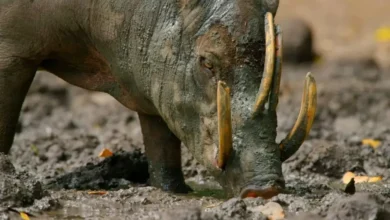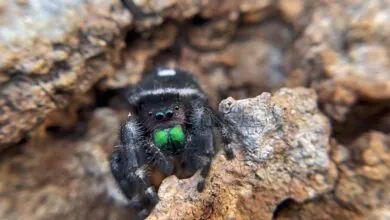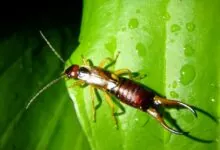Indian Rhino: A Complete Guide to Ecology, Threats, and Protection
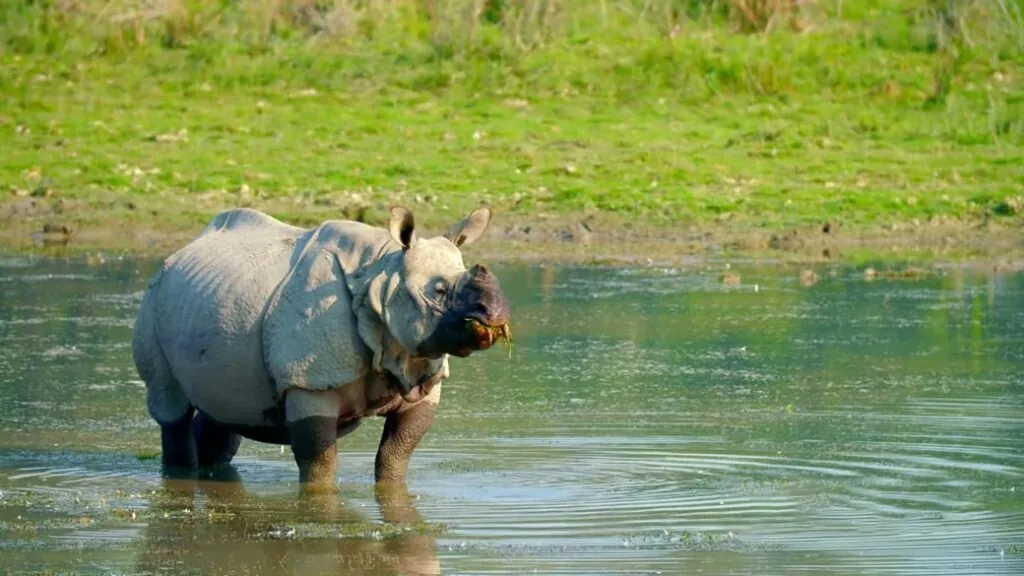
Just see in your mind’s eye a prehistoric giant roaming tall grasslands – its thick hide glistening in the sun. No, it’s not a Jurassic Park sight, but the very real world of the Indian rhino scientifically named as Rhinoceros unicorns. Albeit their majestic size and ancient roots, these towering creatures encounter modern threats that demand our attention. Without further ado, let’s unfold the striking realm of Indian rhinoceros.
| Kingdom | Phylum | Class | Order | Family | Genus | Scientific Name | |
| Animalia | Chordata | Mammalia | Perissodactyla | Rhinocerotidae | Rhinoceros | Rhinoceros Unicornis |
Origin and Evolution
Evolutionary History
The rich weave of the Indian rhino evolution traces back 55 to 50 million years, with their ancient roots planted in North America. Fossil evidence, like the extinct Floridaceras white unearthed in both Florida and Panama, evokes an image of these early rhinos roaming widespread. Nonetheless, around 5 million years back, their reign in North America concluded.
The earliest recognized “proto-rhino,” Hyrachyus eximus, emerged from North America’s Early Eocene epoch. This small creature, identical to early tapirs and horses, lacked the emblematic horn we link with rhinos today.
But around 55 to 60 million years back, the true rhinoceros family branched off from their tapir cousins. Over a hundred species spread across the globe, but solely nine weathered the storms of time, enduring until the Late Pleistocene (14,000-12,000 years ago).
Genetic Composition and Diversity
Fossil evidence puts forward Indian rhinos appeared in the Middle Pleistocene, but genetic studies approximate a much earlier divergence (11.7 million years ago) from their closest relative, the Javan rhino.
Dissimilar to most rhinos with 84 chromosomes, Indian rhinos have 82. Studies unpack the fact that genetic differences between populations in Assam, West Bengal and Nepal, mirroring historical fragmentation.
Environmental Adaptations
In conjunction with the Indian rhinoceros adaptations, their armor-like skin folds with a single horn – up to 25 cm and provides protection from predators and vegetation. These creatures are found in alluvial grasslands and floodplains of the Indian subcontinent, prioritizing tall grasses and water sources. They’re adapted to graze on coarse grasses using their broad prehensile lips and strong incisors.
Mud wallowing and wallowing holes assist to regulate body temperature in hot climates. The function of the Indian rhinoceros horn remains a mystery, possible used in fights or digging for roots and tubers.
Distribution and Population
Geographic Range
Indian rhinoceros are primarily located in India and Nepal, with small population once in blue moon crossing into Bhutan. In India, these rhinos are concentrated in Assam (specifically Kaziranga National Park), with smaller populations in West Bengal and Uttar Pradesh. In Nepal, they can be found in Terai Arc landscape national parks like Chitwan and Parsa.
Population Dynamics
Concerning the India rhino population, it’s around 4,014 individuals as of 2022. In India, around 3,262 rhinos are found with over 90% in Assam. There’re roughly 752 rhinos found in Nepal, with numbers steadily increasing.
The Indian rhinoceros population trends have witnessed an astonishing growth since the 20th century thanks to conservation efforts. Have a glance at the population progress:
Geography
| Continents | Asia |
| Countries | India, Nepal |
| Bio-geographical Realms | Indomalayan |
| Biome | Tropical and subtropical grasslands, savannas, and woodlands |
| Climate Zones | Tropical monsoon climate |
Habitat
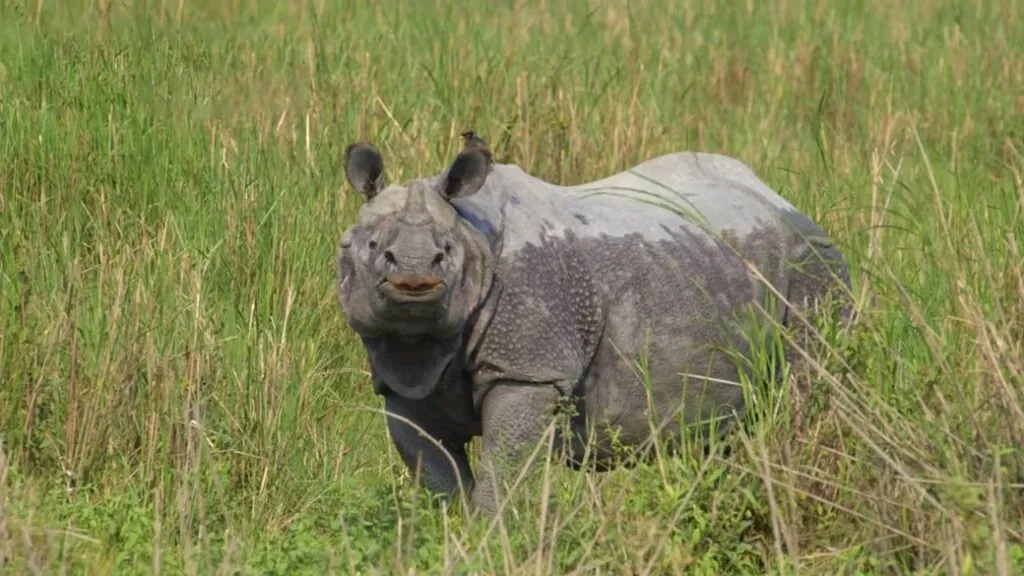
Habitat Preferences
Speaking of Indian rhino habitat, they prefer floodplain grasslands and tall savannas near the foothills of the Himalayas and Brahmaputra Ganges valleys. Their preferred ecosystem also includes reeds, elephant grass and scattered trees within these grasslands that offer shade and shelter. Proximity to water sources like rivers and streams is pivotal for drinking, wallowing and regulating body temperature.
Their specific microhabitats includes dense tall grasslands, riparian zones, edges of forests and sandy or muddy areas for wallowing and dust bathing.
Habitat Utilization Patterns
Indian rhinoceros are predominantly grazers, active during dawn and dusk to avoid extreme heat. Over the span of floods, they might engage in seasonal movements to higher ground or utilize forest edges for temporary shelter.
In terms of their daily activity patterns, early mornings and late afternoons are spent grazing in open grasslands. Midday is used for resting and wallowing in mud or water to cool down.
5 Indian Rhino Facts
Appearance
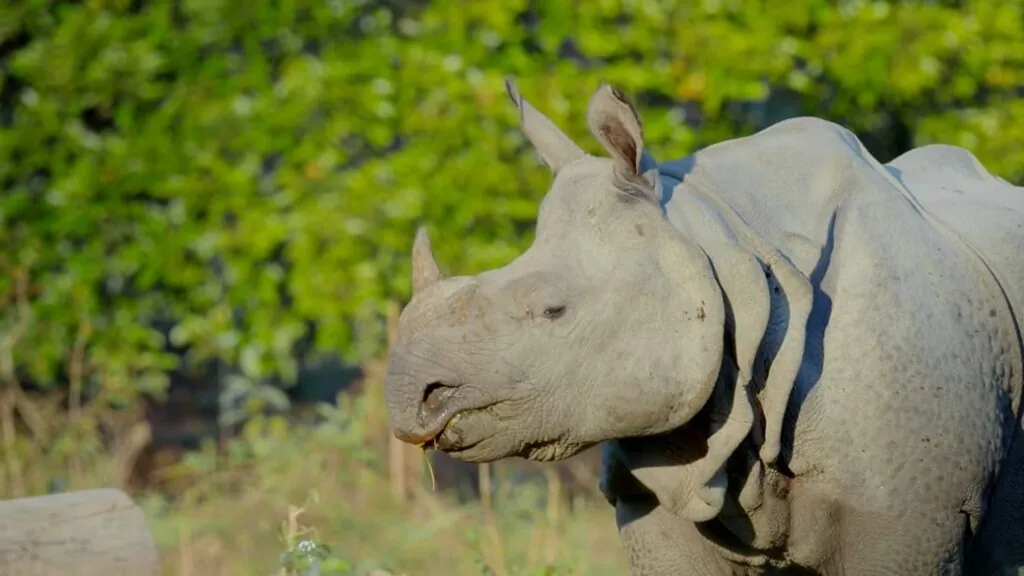
Physical Characteristics
Size: Concerning the Indian rhino size, their heal-body length is 368-380 cm (12.1-12.5 ft) for males and 310-340 cm (10.2-11.2 ft) for females. The height of this largest rhino in Asia is 163-193 cm (5.3-6.4 ft) for males, 147-173 cm (4.8-5.7 ft) for females.
Weight: Speaking the Indian rhinoceros weight, male species have 2,000-2,500 kg (4,400-5,500 lbs) while females boast 1,600-2,000 kg (3,500-4,400 lbs).
Color: These large, stocky creatures with short legs and a heavy head feature gray-brown skin with pinkish skin folds.
Markings: They’ve warty bumps on legs, shoulders and neck. They also have few hairs except eyelashes, ear fringes and tail brush.
Distinctive Features: This greater one-horned rhino boasts a horn measuring up to 25 cm in length.
Sexual Dimorphism
Distinguishing a male Indian rhinoceros from female ones is not that tricky. Males have larger and thicker horns and more conspicuous neck folds. Contrarily, females have thinner horns or no horns at all.
Anatomy
| Color(s) | Greyish-brown with pinkish skin folds |
| Tongue | Rough and prehensile, used for grasping food and vegetation |
| Mouth | Wide, adapted for grazing on grasses and leaves |
| Jaw | Powerful, with grinding molars for tough vegetation |
| Teeth | Incisors for browsing, premolars for grinding, no canines |
| Nose | Large and pointed, with good sense of smell |
| Feet | Three-toed, with thick pads for walking on rough terrain |
| Skeleton | Large and robust, adapted for supporting their considerable weight |
Reproduction and Life Cycles
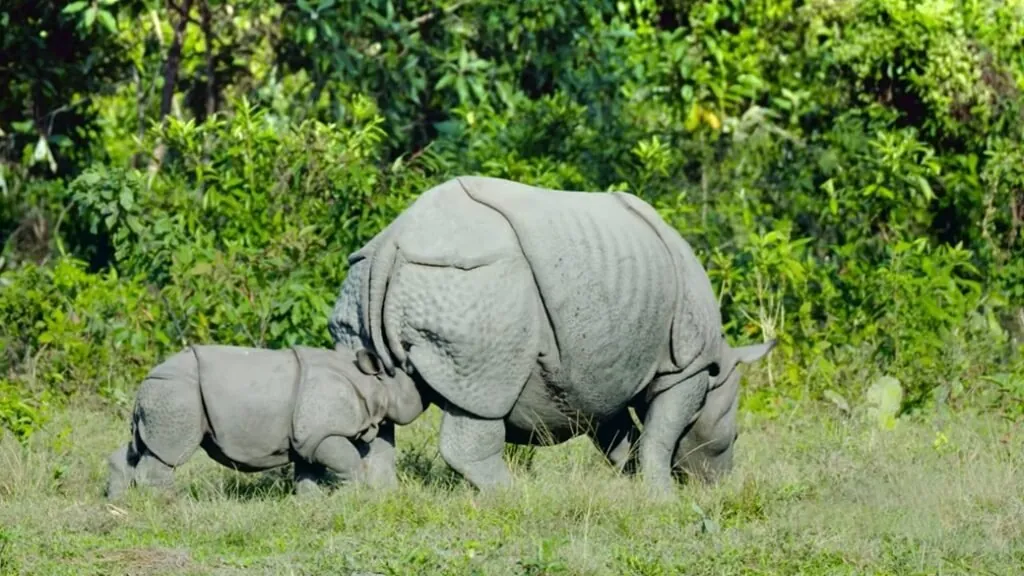
Mating System
The Indian rhinoceros mating system is polygynous, implying males mate with multiple females, defending access to fertile females through displays and fights. However, female Indian rhinos may assess potential partners based on scent, vocalization and physical dominance.
Reproductive Biology
Concerning the Indian rhino reproduction, females advertise their receptivity through urine spraying and marking conspicuous landmarks with scent glands. Males pinpoint these signals and track them down.
Males, before mating, engage in pre-copulatory behavior like chasing, sniffing and gentle nudging to ensure the female’s receptivity.
Gestation Period
The Indian rhinoceros gestation period lasts for 15.7 months – one of the longest gestation period among mammals.
Life Cycle Stages
As for as the Indian rhino lifespan is concerned, they can live up to 45 years in captivity, while in the wild, their lifespan falls approximately 25 to 30 years.
Mating Habits
| Mating Behavior Polygynandrous (multiple mates for both sexes) | |
| Reproduction Season No fixed season, breeding occurs throughout the year | |
| Litter Size Single calf | |
| Gestation Period Approximately 460-480 days | |
| Baby Carrying Internally (placental mammal) | |
| Independent Age Around 4-5 years old |
Diet and Lifestyle
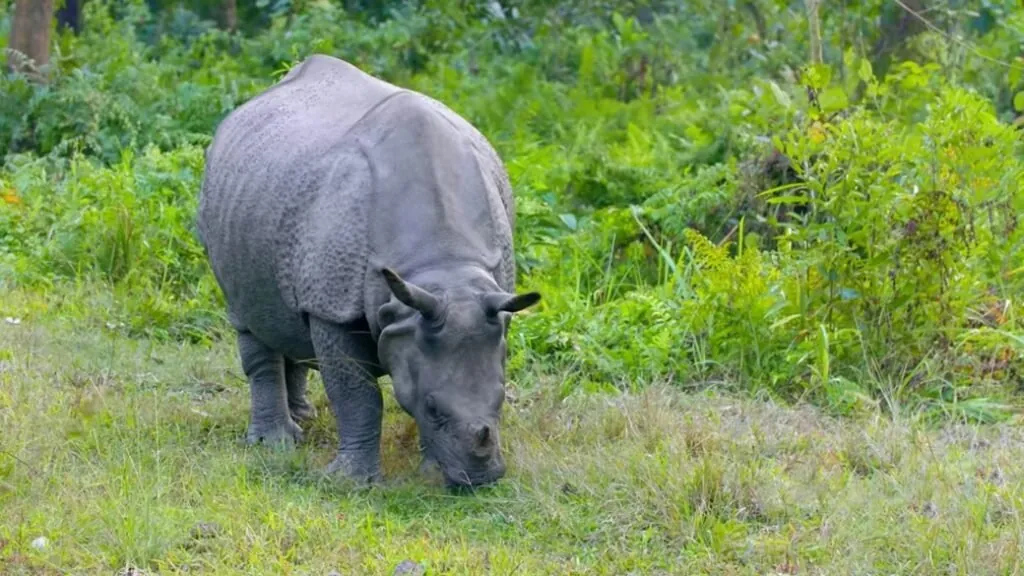
Feeding Ecology
Being herbivores, the Indian rhinoceros are chiefly grazers, consuming grasses, leaves, shoots and fruits. They may in many moons eat aquatic plants, cultivated crops and insects.
Foraging Strategies
These majestic creatures are adapted to efficiently graze on tall grasses making use of their prehensile lips and strong incisors. To avoid midday heat, most foraging activity takes place during cooler hours.
Diurnal Activity Patterns
The Indian rhinoceros is primarily diurnal creature. They’re more active during dawn and dusk when temperatures are cooler.
Social Structure
Essentially, Indian rhinos are solitary creatures except for mothers and their calves that stay together for 3 to 4 years. Once in a blue moon, they may develop temporary aggregations in areas where abundant food or water accessible.
Threats and Conservation
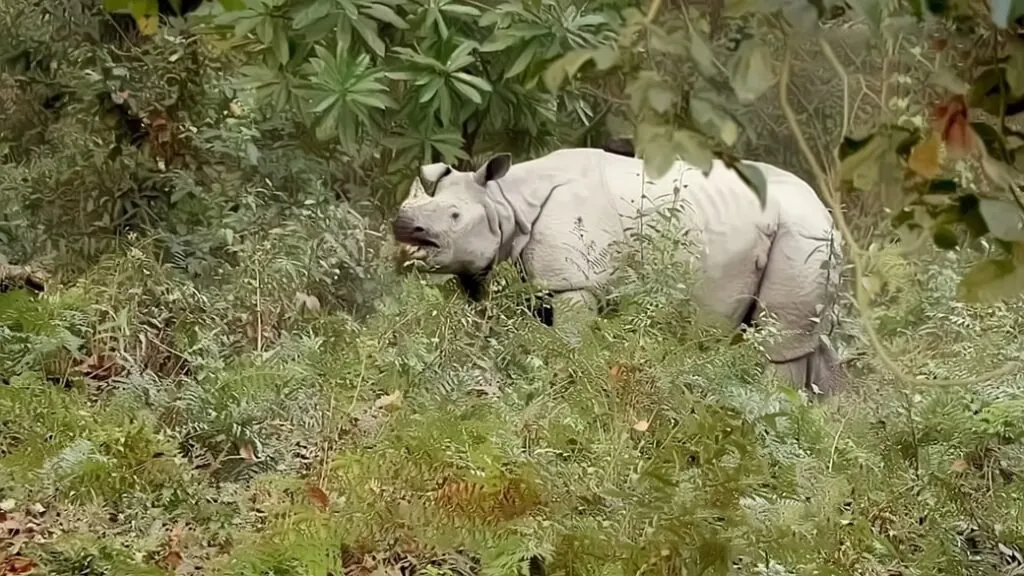
Conservation Status
Though contemporarily the Indian rhino conservation status is listed as Vulnerable by the IUCN Red List, its journey has been awe-inspiring. Once teetering on the edge of extinction with fewer than 200 individuals in the early 1900s, dedicated conservation efforts have been witnessed their population rebound to over 4,000 today.
Primary Threats
Habitat loss: It is the most prominent enemy to Indian rhino’s population. Conversion of grasslands to agriculture – approximated 70% loss in some areas, infrastructure development and human settlements fragment populations.
Poaching: Though having downturn, poaching for horns used in traditional medicine persists. 31 rhinos were poached in India alone in 2014.
Conservation Initiatives
National parks, such as Kaziranga (India) and Chitwan (Nepal) are crucial sanctuaries. Kaziranga conducts unparalleled elephant-back censuses every three years to monitor numbers. India and Nepal have intensified their efforts to combat poaching and have established protected areas, exemplified by Chitwan National Park. Gazetted in December 1970, with borders delineated the following year and officially established in 1973, it initially encompassed an area of 544 square kilometers
The initiatives that have brought a significant decline in poaching incidents include increased ranger patrols, community involvement programs like anti-poaching clubs and stricter law enforcement. Join the global effort to protect these majestic creatures at the World Wildlife Fund’s Rhino Conservation page.
Relationship with Humans
Cultural Significance and Symbolism
In Hinduism, the Indian rhinos are considered as the vahana (vehicle) of the goddess Dhavdi, linked with strength, protection and fertility. In Buddhism, the “Rhinoceros Sutra” praises the solitary lifestyle and stoicism of the rhino, associating it to the ideal of the Pratyekabuddha – an arhat who achieves enlightenment alone.
The rhino’s gigantic size and thick skin make it a natural icon of strength and resilience. Depictions of rhinos can be located in cave paintings and sculptures dating back centuries, mirroring their cultural importance in early civilizations. Illustrated manuscripts such as the “Rhinoceros Sutra” and Mughal paintings depicted the rhino with both realism and symbolism. On the related note, got the scoop of World Rhino Day?
Media and Entertainment
In the realm of art, these species have made their conspicuous presence in multiple genres:
Unique Characteristics
Forge a path through an intriguing journey as we unfold fascinating facts about Indian rhinos – truly captivating animals that start with I. Join us in shedding light on their remarkable rundown!
| Common Name | Indian Rhinoceros |
| Other Name(s) | Greater One-Horned Rhino, Great Indian Rhinoceros |
| Number of Species | 1 (Greater One-Horned Rhinoceros) |
| Population Size | 3,700 individuals |
| Lifespan | 30-40 years in the wild |
| Weight | Males: 2,000-2,500 kg, Females: 1,600-2,000 kg |
| Length | 3.1-3.8 meters |
| Top Speed | 50 km/h (burst) |
| Predators | Bengal tigers, leopards (primarily calves) |
| Diet | Grasses, leaves, shrubs, fruits |
| Most Distinctive Feature | Single black horn on snout |
FAQs

